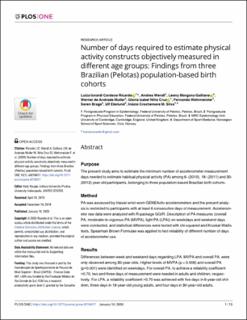| dc.contributor.author | Ricardo, Luiza Isnardi Cardoso | |
| dc.contributor.author | Wendt, Andrea | |
| dc.contributor.author | Galliano, Leony | |
| dc.contributor.author | Muller, Werner de Andrade | |
| dc.contributor.author | Cruz, Gloria Izabel Niño | |
| dc.contributor.author | Wehrmeister, Fernando | |
| dc.contributor.author | Brage, Soren | |
| dc.contributor.author | Ekelund, Ulf | |
| dc.contributor.author | Silva, Inácio Crochemore M. | |
| dc.date.accessioned | 2021-03-20T08:59:12Z | |
| dc.date.available | 2021-03-20T08:59:12Z | |
| dc.date.created | 2021-02-02T10:11:39Z | |
| dc.date.issued | 2020 | |
| dc.identifier.citation | PLoS ONE. 2020, 15(1), Artikkel e0216017. | en_US |
| dc.identifier.issn | 1932-6203 | |
| dc.identifier.uri | https://hdl.handle.net/11250/2734593 | |
| dc.description | This is an open access article distributed under the terms of the Creative Commons Attribution License, which permits unrestricted use, distribution, and reproduction in any medium, provided the original author and source are credited. | en_US |
| dc.description.abstract | Purpose: The present study aims to estimate the minimum number of accelerometer measurement days needed to estimate habitual physical activity (PA) among 6- (2010), 18- (2011) and 30- (2012) year-old participants, belonging to three population-based Brazilian birth cohorts.
Method: PA was assessed by triaxial wrist-worn GENEActiv accelerometers and the present analysis is restricted to participants with at least 6 consecutive days of measurement. Accelerometer raw data were analyzed with R-package GGIR. Description of PA measures (overall PA, moderate-to-vigorous PA (MVPA), light PA (LPA)) on weekdays and weekend days were conducted, and statistical differences were tested with chi-squared and Kruskal-Wallis tests. Spearman Brown Formulae was applied to test reliability of different number of days of accelerometer use.
Results: Differences between week and weekend days regarding LPA, MVPA and overall PA, were only observed among 30-year-olds. Higher levels of MVPA (p = 0.006) and overall PA (p<0.001) were identified on weekdays. For overall PA, to achieve a reliability coefficient >0.70, two and three days of measurement were needed in adults and children, respectively. For LPA, a reliability coefficient >0.70 was achieved with five days in 6-year-old children, three days in 18-year-old young adults, and four days in 30-year-old adults. Considering MVPA, four days would be necessary to represent a week of measurement among all cohort groups.
Conclusion: Our results show that four and five measurement days are needed to estimate all habitual PA constructs, for children and adults, respectively. Also, among 30-year-old adults, it is important to make efforts towards weekend days measurement. | en_US |
| dc.language.iso | eng | en_US |
| dc.subject | physical activity | en_US |
| dc.subject | accelerometers | en_US |
| dc.subject | exercise | en_US |
| dc.subject | cohort studies | en_US |
| dc.subject | age groups | en_US |
| dc.subject | young adults | en_US |
| dc.subject | Brazil | en_US |
| dc.subject | low and middle income countries | en_US |
| dc.title | Number of days required to estimate physical activity constructs objectively measured in different age groups: Findings from three Brazilian (Pelotas) population-based birth cohorts | en_US |
| dc.type | Peer reviewed | en_US |
| dc.type | Journal article | en_US |
| dc.description.version | publishedVersion | en_US |
| dc.rights.holder | © 2020 Ricardo et al. | en_US |
| dc.source.pagenumber | 13 | en_US |
| dc.source.volume | 15 | en_US |
| dc.source.journal | PLoS ONE | en_US |
| dc.source.issue | 1 | en_US |
| dc.identifier.doi | 10.1371/journal.pone.0216017 | |
| dc.identifier.cristin | 1885723 | |
| dc.description.localcode | Institutt for idrettsmedisinske fag / Department of Sports Medicine | en_US |
| dc.source.articlenumber | e0216017 | en_US |
| cristin.ispublished | true | |
| cristin.fulltext | original | |
| cristin.qualitycode | 1 | |
